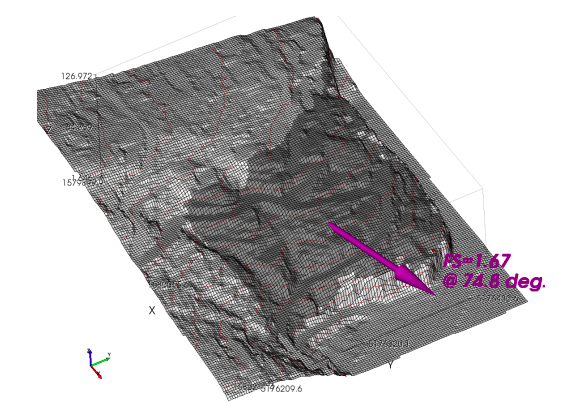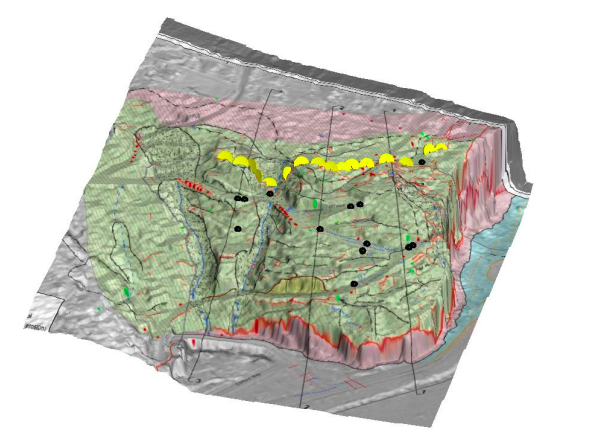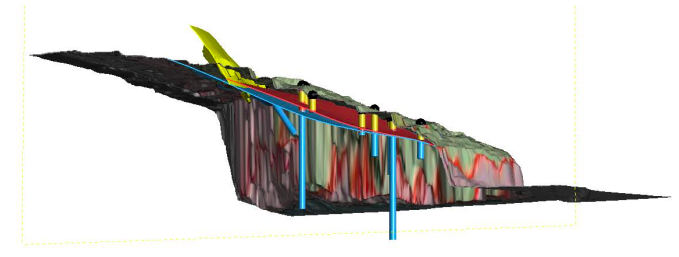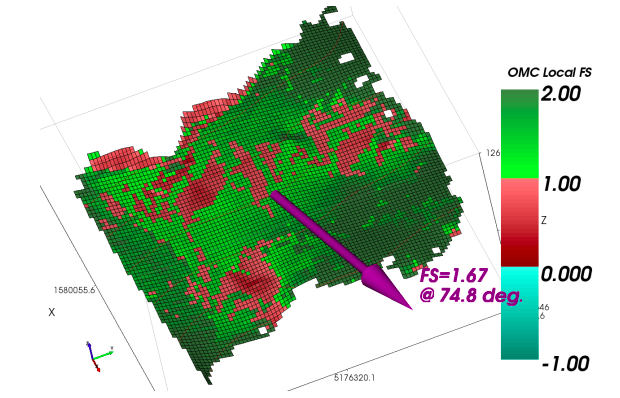By Callum Skinner, Ian Brown
Abstract
Christchurch City and its surrounds experienced a series of damaging earthquakes in 2010 and 2011. During the 22 February 2011 earthquake, extensive cracking and movement of the ground occurred in some areas of the Port Hills. We have used a geological modelling package, Leapfrog3D®, to build 3D models of three of the well documented landslide areas. The surfaces that were developed in Leapfrog3D® have been used in TSLOPE, a new slope stability package, to investigate the 3D effects on slope stability. An objective of our study was to develop a number of slope models that could be used to calibrate computational methods used to predict seismic displacements, and to make these available to other researchers.
1. INTRODUCTION
We have been involved with the development of a slope stability analysis system, TSLOPE, that works with a full 3D model of the slope (TAGAsoft, 2017). As we continue to use the program on different slope problems, we have become aware of the limitations of slope stability analysis using 2D models. In some cases the 2D results are very conservative compared with 3D, and in others they are slightly non-conservative.
It is not always clear where the difference between 3D and 2D results will lie ahead of carrying out comparative analyses. An important part of our software development effort has been to model well documented slope failures and carry out 3D and equivalent 2D analyses.
Following the 22 February 2011 earthquake, extensive cracking and movement of the ground occurred in some areas of the Port Hills, Christchurch City. Eight of these slope failures were very well documented in a series of reports prepared for Christchurch City Council by GNS Science. The report on each area provides all the geotechnical data that were gathered during field investigations, as well as 2D numerical slope stability modelling results.
The Corresponding author mentored a student at University of Canterbury who carried out a 3D slope stability analysis of the Clifton Terrace area (Wilson, 2016), one of the eight areas studied by GNS Science. Following Wilson’s work, we have adopted the methodology he used and built our own model for the Clifton Terrace area.
2. METHODOLOGY
There are various software systems that can be used to create digital slope models, however, we have found Leapfrog3D® (ARANZ Geo, 2017) to be a user friendly and appropriate system to create and edit geologic 3D models. The models we built used publicly available data as shown in Table 1. Christchurch City Council provided the LiDAR[1] data, and the New Zealand Geotechnical Database was used to source drillhole data.
For the model of the Clifton Terrace area, we were able to reproduce the slope model shown in Massey et al. (2014a). The other areas we modelled were Deans Head (Massey et al., 2014b) and Maffeys Road (Della Pasqua et al. 2014). The focus of this paper is on Clifton Terrace, however we will also present the Deans Head model as that serves as an example of the difficulty in building a 3D model when data has not been collected with that as an end objective.
Table 1: Data used to create 3D slope models.
| Data | Description | Source | Date | Use |
| LiDAR digital elevation data | Post 13 June 2011 earthquake LiDAR survey; re-sampled to
1 m grid. |
NZ Aerial Mapping | July – August 2011 | Used to create 3D ground surface for model. |
| Drillhole logs | Results from logging drillholes carried out at or near the site of interest. | Tonkin and Taylor Ltd | 2012 | Used to create 3D surface of geologic units. |
| Drillhole logs | Results from logging drillholes carried out at or near the site of interest. | Aurecon NZ Ltd | 2013 | Used to create 3D surface of geologic units. |
| Geotechnical properties | Results from laboratory and field analysis | GNS Science | 2014 | Used to in models for material properties to constrain failure surfaces/units. |
| Engineering geologic map | Engineering geologic map constructed by GNS Science | GNS Science | 2014 | Used to project significant faults onto the model, geologic unit contacts, ensure drillholes were accurately placed and ensure 2D cross-sections were consistent. |
2.1 3D Modelling Approach
The 3D model for each slope project was built with the following workflow in Leapfrog3D®
- the LiDAR data set was imported and used to build a terrain model;
- the engineering geologic map was georeferenced and draped over the terrain model;
- the terrain model was clipped to only underlie the map extent;
- the drillhole locations and lithology were loaded;
- lithologies were grouped into three units based on engineering properties:
- loess (loess and mixed fill);
- weathered mixed colluvium; and
- volcanics (breccia, basalt and ash).
- the contact between the volcanics and loess was digitised from the draped map to constrain the surface modelling of the geologic units;
- the aerial extent of the loess unit was constrained by the map, and drill holes were used to model loess depth;
- the weathered mixed colluvium was not mapped at surface so was modelled from drillholes to pinch out at the contact between loess and volcanics;
- top of the volcanics was modelled from the drill holes and the mapped contact;
- a tension crack was modelled using the structural disc function in Leapfrog3D®, these were placed along the trend of most intense tension cracking as mapped;
- all modelled surfaces were clipped so that they did not overlap or extend into space; and
- each surface component of the model was then individually exported as a .obj file for loading into TSLOPE.
* LiDAR - Light Detection and Ranging, a remote sensing method that uses light in the form of a pulsed laser to measure distance from the instrument to a reflecting surface.
2.2 Clifton Terrace
The Clifton Terrace model is shown in perspective view in Figure 1. This shows the GNS Science engineering geology map draped on the model. The black dots are drill hole locations, the yellow discs are orientation markers that also define the tension crack location. GNS cross section locations are shown by the black lines that cross the model.
Figure 1. Clifton Terrace model – perspective view
A section through the 3D model is shown in Figure 2, where the cylinders are drill holes, colour coded by lithology, with a modelled surface showing the tension crack (yellow).
Figure 2. Clifton Terrace model – section through 3D model
2.3 Deans Head
Figures 3 and 4 show perspective and section views of the Deans Head model. The drill holes used to construct this model were located more or less on a line, close to one of the section lines used by GNS Science. This meant that there was little useful data out of the plane of the section that could be used to define the surfaces away from the slope and the line of drill holes.
Figure 3. Deans Head model – perspective view
Figure 4. Deans Head model – section through 3D model
2.4 Slope Stability Analysis
The individual surfaces modelled with Leapfrog® along with the georeferenced GNS map were loaded in TSLOPE to form a project for each of the three sites. We represented the slope stratigraphy as Layers, with a surface defining the top of each layer. The three layers were assigned appropriate material properties; for the analyses that we present in this paper, we used the values shown in Table 2.
Table 2: Geotechnical material parameters
| Lithology | Unit Weight (kN/m3) |
Cohesion c’ (kPa) |
Friction ᶲ’ (degrees) |
| Loess | 17 | 10 | 30 |
| Weathered mixed colluvium | 17 | 0 | 21 |
| Volcanics | 18 | 110 | 30 |
TSLOPE’s 3D analysis requires a 3D surface to be defined as the basal failure surface. For each of the slopes we used the surface at top of the colluvium (the interface between loess and colluvium), and the surface at the base of the colluvium. A groundwater surface was also transferred from Leapfrog3D®.
Each model was then analysed in 3D using Spencer’s method (Spencer, 1967), a limit equilibrium analysis method that fully satisfies force and moment equilibrium. Similar overall factors of safety were also obtained using the Ordinary Method of Columns which is used to obtain the starting estimate of the factor of safety for Spencer’s Method. The models were also analysed in 2D along the same cross-sections used by GNS Science.
We present the results obtained for our Clifton Terrace slope model to illustrate the differences between 3D and 2D analyses.
A 3D slope case with the failure surface at the top of the colluvium is shown in Figure 5. TSLOPE discretises the slope into vertical columns; the active columns are the dark coloured columns. Figure 5 shows the factor of safety (FS) computed by Spencer’s method and the bearing of the sliding direction.

Figure 5. Clifton Terrace TSLOPE 3D model.
TSLOPE also uses a 3D formulation of the Ordinary Method of Slices, known as the Ordinary Method of Columns (OMC). This assumes no inter column transfer of forces, and the factor of safety is defined as the sum of the resisting forces divided by the sum of the driving forces.
We can then investigate the distribution of the local factor of safety (OMC Local FS) as shown in Figure 6. This allows visualisation of the columns that are resisting sliding (green colours) and those that are not (red colours). We used the Clifton Terrace TSLOPE model to build two 3D slope cases, and two 2D slope cases. The results of the analyses are summarised in Table 3.
Table 3: TSLOPE results

Figure 6. Clifton Terrace TSLOPE failure surface at top of colluvium
3. DISCUSSION
Table 3 shows that there is a difference between factors of safety calculated using 2D and 3D formulations of Spencer’s method. For these slope cases, the 2D factors of safety are lower, suggesting that the variable shape of the failure surface relative to the ground surface provides resistance to sliding that cannot be taken into account with a 2D analysis.
This also impacts on the calculation of a yield acceleration, applying the standard pseudo-static approach commonly used in limit equilibrium analyses.
Similar differences between 2D and 3D results were obtained from the Deans Head and Maffeys Road models.
We also noted some small differences in the sections used for 2D analysis, and those presented by GNS Science at the same location. We expect that these differences are because our sections were produced from a 3D model, whereas “hand estimated” sections may not reflect out of plane data points and the influence that they have on the projection of a surface.
The data available for the Deans Head model may also reflect the 2D approach that is commonly used for slope problems. In this case, the few drill holes were aligned in the line of the section used for stability analysis. This meant that there were few data out of the 2D plane that we could use to constrain the modelled surfaces.
4. CONCLUSIONS
The Leapfrog3D®models that we have prepared for the Clifton Terrace, Deans Head, and Maffeys Road areas of Christchurch Port Hills complement the earlier work by GNS Science. These models have provided detailed 3D surfaces that were required as input to TSLOPE projects for each area. The analyses we have carried out of the slopes confirmed that 3D effects are important when considering slope stability.
The Leapfrog3D® models are available to use for calibration and validation of computational methods used to predict seismic displacements. We are happy to share these models with other researchers.
5. ACKNOWLEDGMENTS
ARANZ Geo Ltd, developers of Leapfrog3D® provided assistance with the use of their 3D modelling software. Mr Peter Wood of TAGA Engineering Software Ltd assisted us with application of TSLOPE. Dr Chris Massey of GNS Science reviewed the 3D geological models. Mr Jonathan Wilson made the initial 3D model of the Clifton Terrace area. Mr Peter Kingsbury at Christchurch City Council provided support for this study.
REFERENCES
ARANZ Geo (2017) Leapfrog3D® http://www.leapfrog3d.com ARANZ Geo Ltd
Della Pasqua, F., Massey, C.I., Lukovic, B., Ries, W., Archibald, G., Heron, D. (2014) Canterbury Earthquakes 2010/11 Port Hills Slope Stability: Risk assessment for Maffeys Road. GNS Science Consultancy Report 2014/79.
Massey, C.I., Della Pasqua, F., Lukovic, B., Yetton, M.D., Archibald, G., Ries, W. (2014a) Canterbury Earthquakes 2010/11 Port Hills Slope Stability: Risk assessment for Clifton Terrace. GNS Science Consultancy Report 2014/76.
Massey, C.I., Della Pasqua, F., Taig, T., Lukovic, B., Ries, W., Heron, D. (2014b) Canterbury Earthquakes 2010/11 Port Hills Slope Stability: Risk assessment for Deans Head. GNS Science Consultancy Report 2014/77.
Spencer, E. (1967) A method of analysis of the stability of embankments assuming parallel interslice forces. Geotechnique 17: p11-26.
TAGAsoft (2017) TSLOPE https://tagasoft.com/tslope-technical-information/ TAGA Engineering Software Ltd
Wilson, J.J. (2016) A three dimensional slope stability analysis of the Clifton Terrace mass movement area, Christchurch. Unpublished research report for Professional Master of Engineering Geology, University of Canterbury






